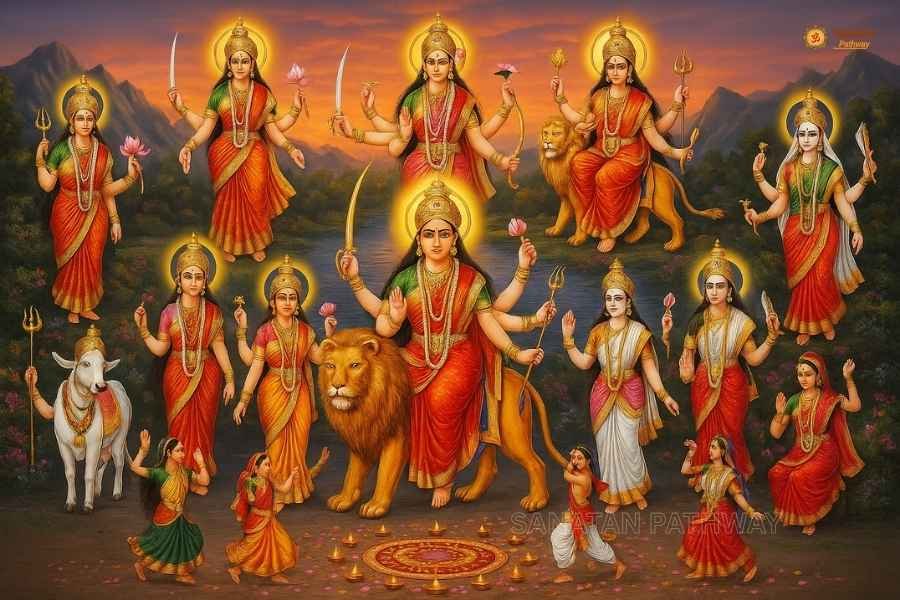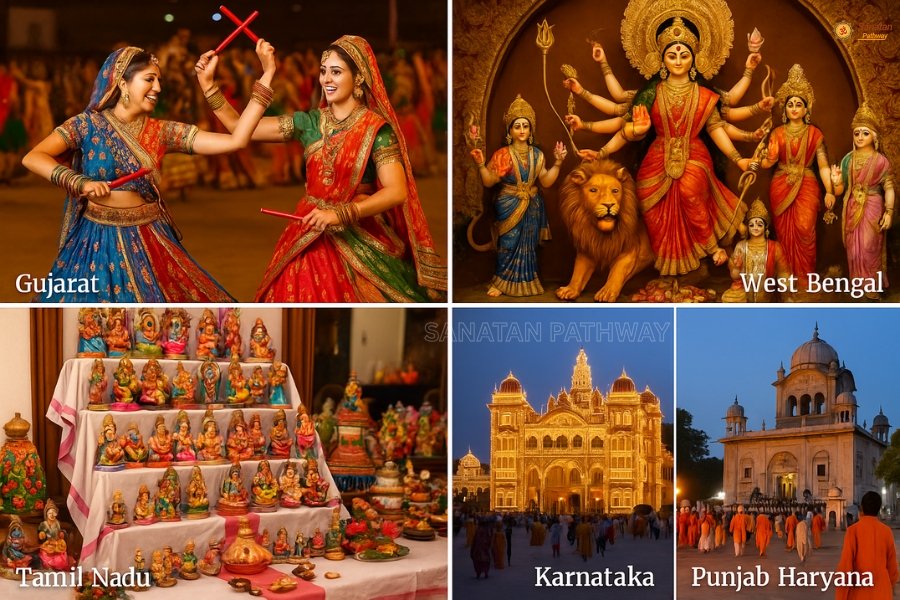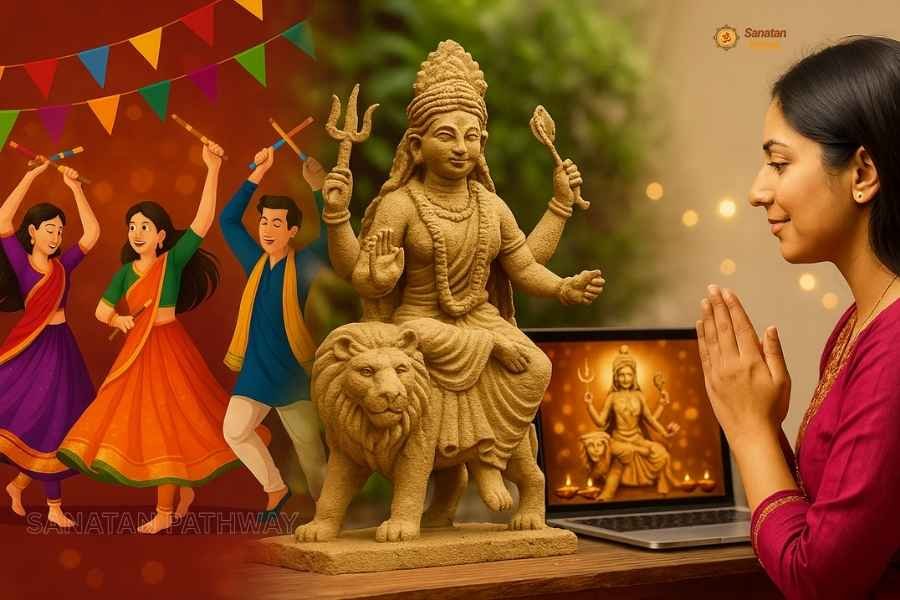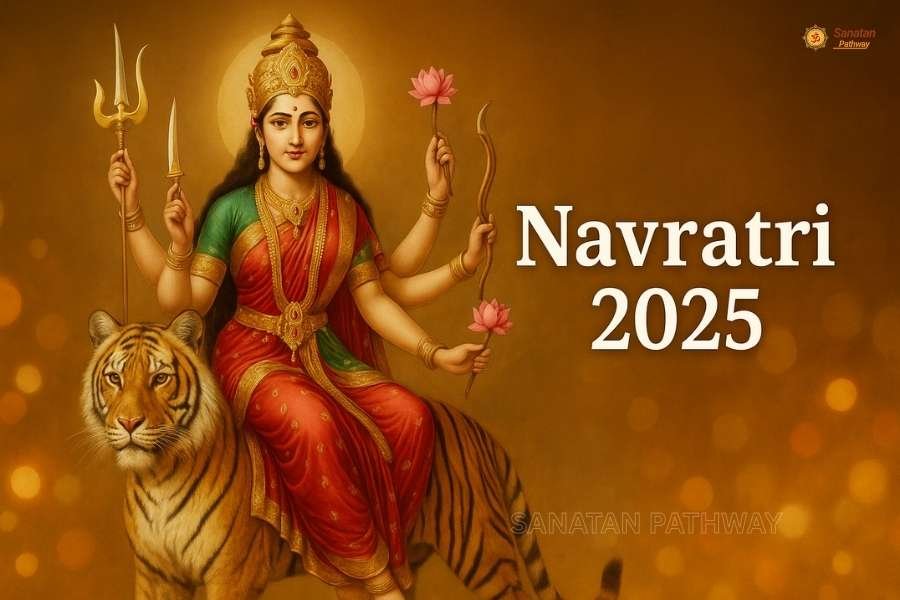India is a country of many auspicious Festivals. One among them is Navratri, which is celebrated with immense joy and devotion throughout the nation. Navratri is one such festival that truly reflects this spirit. Like many other Indian festivals, Navratri is celebrated passionately in every corner of the country. With each region following its own unique traditions, one can witness the beauty of India’s cultural diversity.
Navratri is dedicated to Goddess Durga and her nine divine forms. The term ‘Navratri‘ comes from the Sanskrit words ‘nava’, meaning ‘nine’, and ‘ratri’, meaning ‘nights.’ During these sacred days, devotees engage in fasting, prayers, and many forms of cultural festivities to worship her nine manifestations.
In 2025, Navratri will begin on September 22 (Monday) and conclude on October 1 (Wednesday). It is a period of nine days of devotion, with each day treated with reverence according to the regional customs across India.
This post will summarize Navratri 2025 — its history, spiritual significance, the nine forms of Goddess Durga, fasting rules, and the vibrant ways it is celebrated in today’s times.
Navratri 2025: Dates and Tithi
Here are the important dates and tithis for Navratri 2025:
- Day 1 (September 22, Monday): Pratipada – Worship of Maa Shailputri
- Day 2 (September 23, Tuesday): Dwitiya – Worship of Maa Brahmacharini
- Day 3 (September 24, Wednesday): Tritiya – Worship of Maa Chandraghanta
- Day 4 (September 25, Thursday): Tritiya – Worship of Maa Chandraghanta
- Day 5 (September 26, Friday): Chaturthi – Worship of Maa Kushmanda
- Day 6 (September 27, Saturday): Panchami – Worship of Maa Skandamata
- Day 7 (September 28, Sunday): Shashti – Worship of Maa Katyayani
- Day 8 (September 29, Monday): Saptami – Worship of Maa Kalaratri
- Day 9 (September 30, Tuesday): Ashtami – Worship of Maa Mahagauri
- Day 10 (October 1, Wednesday): Navami – Worship of Maa Siddhidatri
The festival concludes with Vijayadashami (Dussehra) on October 2, 2025 (Thursday), symbolizing the triumph of righteousness over evil.
Why Navratri 2025 is Special
There is an auspicious time for everything, and when that moment arrives, it is believed that prayers and devotion become even more fruitful. Sharad Navratri 2025 falls during a period of high spiritual energy and seasonal transition, making it especially significant for devotees.
Interestingly, in 2025, there are two dates for Tritiya — September 24 and 25. This event adds extra importance, as devotees receive one more day to immerse themselves in prayer, fasting, and devotion to Maa Durga.
The Spiritual Significance of Navratri
The nine days of Navratri symbolise the victory of good over evil. According to Hindu scriptures, during these nine sacred days, Goddess Durga fought and defeated the demon Mahishasura. This is why these days are called Navratri. The tenth day of his death is celebrated as Vijayadashmi or Dussehra.
Navratri is collectively known as the nine aspects of Goddess Durga, or Navdurga. The Goddess blesses her devotees with strength, wisdom, and prosperity, while also protecting them from negativity.
The sacred days of Navratri are not only confined to external worship, but are more about inner cleansing, self-discipline, and spiritual awakening. So if you want a balance among your body, mind, and soul, you must offer prayers and observe fasting during these days.
The Nine Forms of Goddess Durga (Navadurga)
Each day of Navratri is devoted to one of the nine forms of Maa Durga:
- Shailputri – The daughter of the Himalayas, symbolizing strength.
- Brahmacharini – The goddess of penance and devotion.
- Chandraghanta – The warrior goddess who blesses courage and protection.
- Kushmanda – The creator of the universe, bringing vitality and energy.
- Skandamata – The mother of Lord Kartikeya, symbolizing motherhood and compassion.
- Katyayani – The fierce form who destroyed Mahishasura.
- Kalaratri – The dark and powerful form that removes negativity.
- Mahagauri – The goddess of purity, peace, and forgiveness.
- Siddhidatri – The bestower of siddhis (spiritual powers) and divine blessings.

Navratri Fasting Rules and Rituals
To receive the blessings of Goddess Durga and attain internal purification, devotees are required to observe fasting on these holy days. Fasting is considered the essence of Navratri, and devotees undertake it in different ways in accordance with their various customs and regional practices. Here are some important dos and don’ts to follow during fasting:
- Accepted Food Items:
Devotees can consume sabudana (sago), kuttu (buckwheat flour), singhara (water chestnut flour), seasonal fruits, nuts, potatoes, sweet potatoes, and rock salt. - Avoided Food Items:
Onion, garlic, and non-vegetarian foods are avoided due to their tamasic nature. Similarly, wheat flour, rice, and pulses are not consumed, as they are considered heavy and may make the mind restless. - Daily Worship Rituals:
Lighting a diya (lamp), offering flowers, chanting mantras, Durga Saptashati recitation, and to some other forms of Durga should be practiced daily, as these are in her devotion and are thought to be empowering. - Kanya Puja (Ashtami/Navami):
On the eighth or ninth day (depending on regional tradition), young girls are worshipped as embodiments of the Goddess. They are offered prasad (such as puri, halwa, and chana) along with gifts or dakshina.
Fasting is a means of purification of the body and the mind. It also provides devotees the opportunity to feel closer to the supreme Godhead.
Cultural Celebrations of Navratri Across Indian States
In India, every state has its own unique way of celebrating Navratri:
Gujarat: This state is renowned worldwide for its centuries-old traditional dance, the Garba, and the Dandiya Raas dance events. As dusk falls, people gather in colorful traditional attire, dancing gracefully to the rhythm of folk music, and celebrate with music and dance.
West Bengal: This state is Famous for its grand Durga Puja, where artisans craft beautiful idols of Maa Durga. People worship the Goddess with devotion, accompanied by cultural performances and processions.
Maharashtra: Just like the grand celebration of Ganesh Chaturthi, the people of Maharashtra don’t lag in Navratri either. They show their deep devotion by setting up Ghat Sthapana at home and celebrating by observing fasting, singing bhajans, and attending community events.
Tamil Nadu: In this state, Navratri is celebrated as the Golu Festival, where dolls are decorated and dressed in the traditional attire of the region where Navratri is celebrated. Beautifully decorated dolls are placed on the stairs. During this time, women also invite each other for the Haldi-Kumkum ceremony.
Karnataka: Here, Navratri is known as Mysore Dussehra, a royal festival marked by grand processions, cultural events, and the majestic Mysore Palace illuminated like a dazzling jewel.
Punjab & Haryana: Here, the festival is popularly known as Navratra. Devotees observe strict fasting and visit famous shrines and temples, such as Chintpurni and Vaishno Devi. The spirit of devotion spreads widely during these days.

Looking at this diversity, it’s clear that Navratri is one of the most vibrant festivals of India, uniting people through faith, culture, and celebration.
Navratri in Modern Times
In today’s world, Navratri beautifully blends tradition with festivity. While the essence of the festival remains deeply spiritual, the style of celebration has evolved with time:
- The enthusiastic participation of youth in Garba and Dandiya nights organized by clubs, housing societies, and community grounds adds a modern flavor to the age-old tradition.
- For devotees living outside India or far from famous shrines, temple committees now live-stream Navratri pujas, ensuring everyone stays connected spiritually.
- With growing environmental awareness, artisans are creating eco-friendly Durga idols, making sustainable celebrations more popular across the nation.
- In the digital age, social media platforms overflow with Navratri greetings, reels, devotional songs, and virtual celebrations, making the festival’s arrival known to the world instantly.

Tips for Celebrating Navratri 2025 Spiritually
- Wake up early before sunrise and begin your day with meditation and the holy chanting of Durga mantras.
- Be mindful of your food and thoughts. Consume only sattvic food and surround yourself with positivity.
- Whenever possible, visit temples daily and take part in community bhajans and devotional programs.
- Attain inner peace through charity by donating food, clothes, or money to the needy.
- Decorate your place of worship beautifully with flowers and diyas to please Goddess Durga.
Conclusion
Navratri 2025 is not just a festival marking the victory of Goddess Durga, Shakti, and the Navadurga — it is also an opportunity to awaken the spiritual energy that lies within each of us. These nine days encourage us to revive sacred traditions, purify our minds and hearts, and strengthen our connection with the Divine.
In today’s times, while people often focus on the Garba festivities and ecstatic celebrations, it is important to remember the deeper essence of Navratri — pooja, fasting, devotion, and the inner light one discovers within.
Even when negativity surrounds us, Goddess Durga continues to inspire hope by restoring Dharma. May her unyielding compassion remain like a North Star, guiding us toward honesty, joy, and spiritual fulfillment throughout our lives.

I’m Manohar Prajapat, founder of Sanatan Pathway.I write about Sanatan Dharma, Bhakti Leela, Hindu festivals, and the timeless wisdom of the Vedas — to help people live a more peaceful, dharmic life rooted in Indian spirituality.🕉 Read more at sanatanpathway.com

1 thought on “Navratri 2025: Its Significance, Dates, Rituals, Rules of Fasting & Celebrations in India”